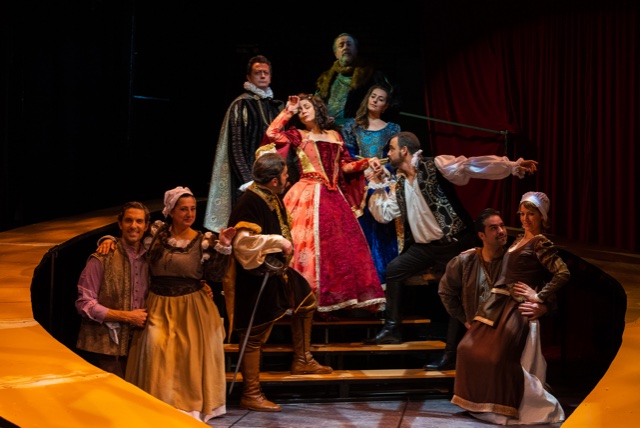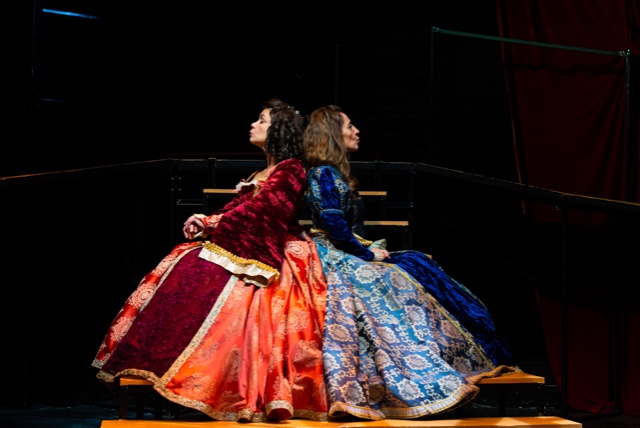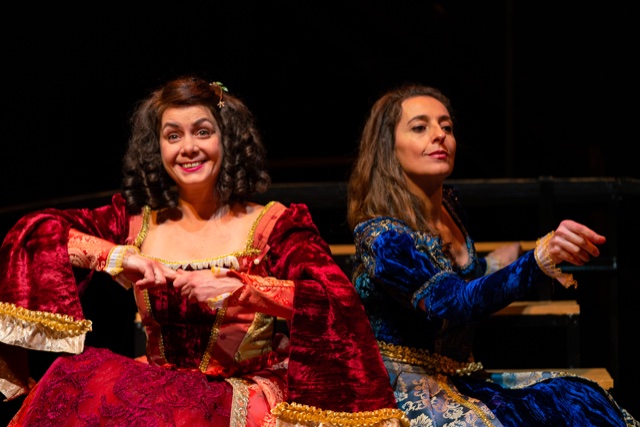Repertorio Espanol Mounts La Dama Boba
Lope de Vega Amuses and Moves
By: Rachel de Aragon - Feb 22, 2022
Repertorio Espanol Presents
La Dama Boba by Lope de Vega
Adaptation and Direction by Leyma Lopez
We are taken back 400 years by the authentic costuming by Leni Mendez and assistant Gabriela Corretjer. The austere, simply rendered and subtly illuminated set by Robert Weber Federico (set and lighting design) hints at a palatial interior with a broad central staircase and two non-symmetrical ramps. We are in Madrid at the home of Higaldo Octavio (Frank Rodriguez). Rodriguez opens the scene in heated conversation with his friend Maestro Miseno, (Gerardo Gudino) tutor to his daughters. Despite the serious tone and the gravity with which the dilemma of the plot unfolds, Dama Boba is a comedy.
Octavio would like to see his two beautiful daughters Nise (Maria Fontales) and Finea (Zulena Clares) successfully married. Nise is a woman renown for her scholarly intellect, and much admired by poets and philosophers throughout Spain, but she has a very meager dowry.
Finea, on the other hand, has a dowry four times as large, but can not even manage a sensible sentence. She is the boba, best translated as booby, a person who lacks both intelligence and grace. The lopsided distribution of their dowries was made by their uncle. Perhaps it was to compensate for the disparity in their potential or perhaps, as Octavio affirms, because the man was none too bright himself. And so as our scene is set, Octavio is hosting their suitors in the spirit of paternal optimism.
The dashingly handsome impoverished poet, Laurencio (Ariel Texido) and the stalwart well educated caballero Liseo (Sandor Juan) have come to win Octavio's daughters. Their respective servants, Pedro (Cesar Cova Burguera) and Turin (Fernando Gazzaniga) and the serving women of the two prospective brides Clara (Sandra Gumuzzio) and Celia, (Mariana Buoninconti) provide parallel action which serves to intensify the comedic mood.
Lope deVega is not simply setting us up for a good laugh. The play takes a sharp look at the meaning of the ideal woman. What attributes are truly important? Is there room in marriage for the intellectually driven woman? Is there room for the woman who cannot enhance her husband's social standing? Is economic security the real motive for our emotional commitments?
Lope deVega casts a doubtful shadow on the excesses of highly intellectualized romance, as well as and on the notion that good looks and fecundity are all that make for a good wife. It is worth noting that Lope deVega is at the center of Spain's Golden Age. Like Cervantes and Calderon he reflects a time of social change.
Lopez takes the modernity of these concepts as central to our experience. She has skillfully rearranged our introduction to both the plot and the characters and plunges directly into the juice of the drama. The reduced the number of extra characters helps to bring a powerful intimacy to the stage. We have moved beyond the stylization and rhetorical rhymes popular at the turn of the 16th century. The use of music (Dafnis Prieto) and dance (Omar Nieves) underscore the present nature of these questions in the 21st century.
Clares as the Dama Boba keeps smiles on our faces as she moves through her foolish persona into a woman caught by the inspiration of true love. Lope deVega is a romantic. He asks us to believe in love. As a comedy we leave satisfied by both its romanticism and its wit. And yet, although Lopez gives voice to some new social choices, we cannot help but wonder if our romantic sensibilities and matrimonial expectations have changed all that much in the last 400 years.
The play is presented in Spanish with true to meaning English subtitles by Sara Buitrago. For Spanish speakers who may wonder if 16th century Spanish is comprehensible. It is. It has changed far less than English has since Shakespeare wrote. Tickets here.




